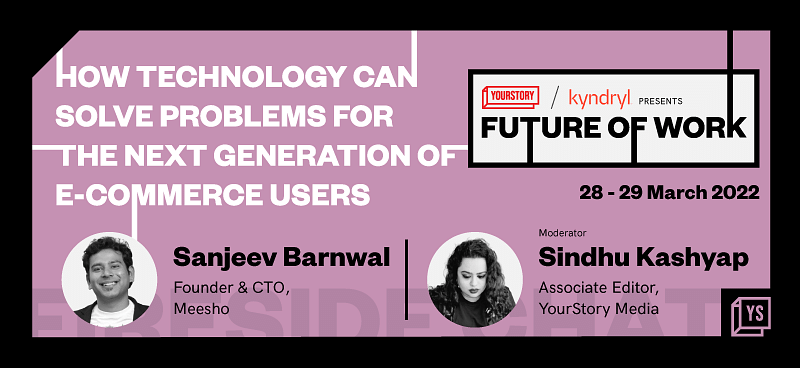Social commerce startup has had an extraordinary run. Having turned a unicorn in April 2021, the Bengaluru-based company has been transforming the way Indian buyers and sellers traditionally communicated in the marketplace. With millions of entrepreneurs finding space in its fold, Meesho is poised to venture deeper into the social commerce segment.
However, that is not the only reason why the startup has been in the news lately. Meesho recently announced their work-from-anywhere policy, and it has taken the internet by storm. The model focuses on having a boundary-less workplace where employees can opt to work from home, office, or any location of their choice. This flexible approach is quite possibly the ‘future of work’.
Delving deep into the future of ecommerce was Sanjeev Barnwal, Founder and CTO (chief technology officer), Meesho, who shared some valuable insights into how technology can solve problems for the next-generation of ecommerce users at YS’s Future of Work conference 2022.
Leveraging tech for retail
“Technology has completely transformed the ecommerce industry,” said Sanjeev. “The pandemic has accelerated this transformation. Probably what would have taken years has happened in a matter of months.”
When the COVID-19 pandemic hit, a large number of consumers were pushed into buying products online. This, in turn, resulted in them having an experience that they would not have had earlier. “The pandemic forced people to go digital, and buying online generally had a lot of barriers to entry with trust being one of the key factors,” he added.
The consumer perspective, especially when it comes to the younger generation, has changed. This target audience is looking for something beyond just shopping. They do not merely want a product, but also expect to have a unique buying experience as well. “It has forced many companies to invest in more personalised experiences,” pointed out Sanjeev. “Consumers expect the platform to implicitly understand what is going on in their minds,” he added.
The expectation to gain more out of platforms is starkly different from how ecommerce used to function a few years ago. At that point, there was greater reliance on the search button. Users would have to look and browse through products to find what they wanted, but now, the offering has switched to suggesting products to them based on their tastes and preferences.
“With more discovery-led and browsing-led shopping experiences, consumers are spending a lot more time on ecommerce platforms. They’re now expecting these platforms to leverage all these signals, and personalise their entire feed,” explained Sanjeev.
AI and the trend bucket
The pandemic brought about significant shifts inducing the company to realign its goals. “When the pandemic started, we saw a massive increase not only in the number of users but also the time spent by every user on Meesho,” shared Sanjeev.
The time spent was comparable to the hours that users generally spent on social media and messaging apps. There were many people who turned to the app to just browse through new products that were cropping up. It was at this point the company realised that personalising the user’s feed should be prioritised. “In our kind of marketplace where you have unbranded products, there are infinite options as opposed to a marketplace that is targeted towards brands, which have a limited set of products. In our case, it is even more important to understand the customer’s intent implicitly,” highlighted Sanjeev, giving a lesson in intuitive product design.
It is critical to understand the types of products that the customer is looking at, the time they spend on each product, and the various price-points. “When we launched our personalisation algorithm, it gave us up to 50 percent improvement in order per user,” he added.
Users do not tell the platform what they want to buy, and that is where AI (artificial intelligence) fits in. It understands the complexities based on consumer behaviour online to cater and screen products that users will probably purchase. “The kind of suppliers we deal with are new to ecommerce platforms, and are selling for the first time. So, in the absence of complete data, how would the algorithm understand what the product is by looking at incomplete descriptions provided by suppliers? It has to look at the product colour and image, and this is done quickly by the algorithm every time a user shows up,” he explained.
Inside the world of immersive tech
“At college I never thought of starting up,” exclaims Sanjeev. “I wanted to create something that would have a huge impact. I didn’t have clarity on what domain or tech, but knew it had to have some impact because you’re in a position to do that.”
While that was the main inspiration behind the call for starting up, Sanjeev also pointed out how despite the business model itself undergoing several changes, the focus remains on helping small businesses — traditionally left out of the ecommerce space — become successful online.
The lines between social and commerce are increasingly getting blurred. “Users have started treating ecommerce as a social media platform. They’re spending a lot of time on it, and in many cases they’re just opening the app to understand newer trends. They’re also trying to stay connected with the suppliers because they have built that trust with specific suppliers,” he added.
Another rising trend is the active seeking of validation through online purchases. The first generation of ecommerce was intent on increasing access to products that were not always available offline. However, it was quite static in nature. With later ecommerce platforms, though, immersive technology letting consumers interact with the products they view online is key.
As a space that continues to grow, there is ample opportunity for founders and techies to explore. “Having an open mind to the kind of role that you’re going to play for a company keeps changing. The only thing that matters is your ability to go ahead and understand the problems that your user is facing, and quickly iterate to the right solution,” signed off Sanjeev.
Catch all the Future of Work sessions here.










